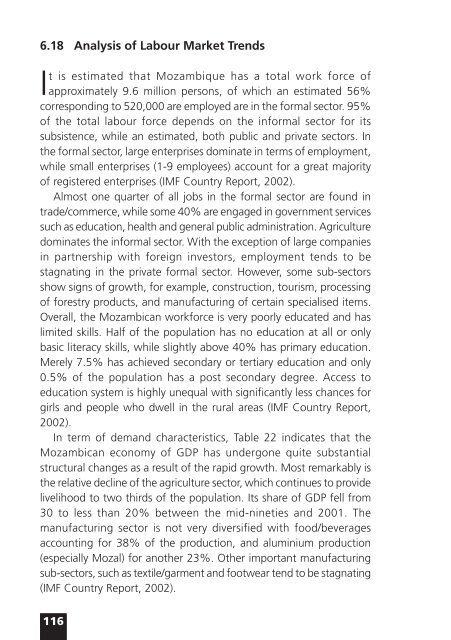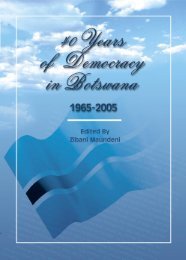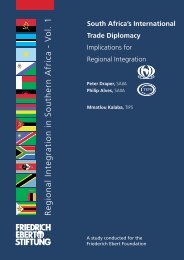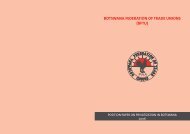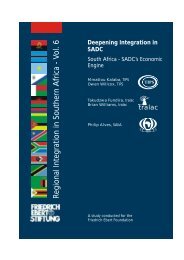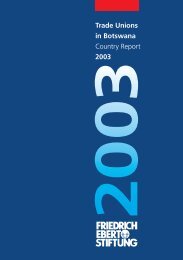Deepening Integration in SADC - Fes-botswana.org
Deepening Integration in SADC - Fes-botswana.org
Deepening Integration in SADC - Fes-botswana.org
Create successful ePaper yourself
Turn your PDF publications into a flip-book with our unique Google optimized e-Paper software.
6.18 Analysis of Labour Market Trends<br />
I t is estimated that Mozambique has a total work force of<br />
approximately 9.6 million persons, of which an estimated 56%<br />
correspond<strong>in</strong>g to 520,000 are employed are <strong>in</strong> the formal sector. 95%<br />
of the total labour force depends on the <strong>in</strong>formal sector for its<br />
subsistence, while an estimated, both public and private sectors. In<br />
the formal sector, large enterprises dom<strong>in</strong>ate <strong>in</strong> terms of employment,<br />
while small enterprises (1-9 employees) account for a great majority<br />
of registered enterprises (IMF Country Report, 2002).<br />
Almost one quarter of all jobs <strong>in</strong> the formal sector are found <strong>in</strong><br />
trade/commerce, while some 40% are engaged <strong>in</strong> government services<br />
such as education, health and general public adm<strong>in</strong>istration. Agriculture<br />
dom<strong>in</strong>ates the <strong>in</strong>formal sector. With the exception of large companies<br />
<strong>in</strong> partnership with foreign <strong>in</strong>vestors, employment tends to be<br />
stagnat<strong>in</strong>g <strong>in</strong> the private formal sector. However, some sub-sectors<br />
show signs of growth, for example, construction, tourism, process<strong>in</strong>g<br />
of forestry products, and manufactur<strong>in</strong>g of certa<strong>in</strong> specialised items.<br />
Overall, the Mozambican workforce is very poorly educated and has<br />
limited skills. Half of the population has no education at all or only<br />
basic literacy skills, while slightly above 40% has primary education.<br />
Merely 7.5% has achieved secondary or tertiary education and only<br />
0.5% of the population has a post secondary degree. Access to<br />
education system is highly unequal with significantly less chances for<br />
girls and people who dwell <strong>in</strong> the rural areas (IMF Country Report,<br />
2002).<br />
In term of demand characteristics, Table 22 <strong>in</strong>dicates that the<br />
Mozambican economy of GDP has undergone quite substantial<br />
structural changes as a result of the rapid growth. Most remarkably is<br />
the relative decl<strong>in</strong>e of the agriculture sector, which cont<strong>in</strong>ues to provide<br />
livelihood to two thirds of the population. Its share of GDP fell from<br />
30 to less than 20% between the mid-n<strong>in</strong>eties and 2001. The<br />
manufactur<strong>in</strong>g sector is not very diversified with food/beverages<br />
account<strong>in</strong>g for 38% of the production, and alum<strong>in</strong>ium production<br />
(especially Mozal) for another 23%. Other important manufactur<strong>in</strong>g<br />
sub-sectors, such as textile/garment and footwear tend to be stagnat<strong>in</strong>g<br />
(IMF Country Report, 2002).<br />
116


